Lasing from Micro- and Nano-Scale Photonic Disordered Structures for Biomedical Applications
Abstract
:1. Introduction
2. Fundamentals of Random Lasing
2.1. Light Propagation in Random Structures
Coherent Backscattering (CBS) Experiment
2.2. Scattering Induced Feedback for Lasing
2.3. Characteristics of Random Lasing

3. Random Lasers—Materials and Types
3.1. Active and Passive Random Lasers
3.2. Colloidal and Flexible Random Lasers
3.3. Random Lasers from Biological and Bio-Inspired Structures
4. Biomedical Applications of Random Lasing
4.1. Imaging Applications
4.2. Sensing Applications

5. Conclusions
Author Contributions
Funding
Data Availability Statement
Acknowledgments
Conflicts of Interest
References
- Wiersma, D.S. Disordered Photonics. Nat. Photonics 2013, 7, 188–196. [Google Scholar] [CrossRef]
- Burresi, M.; Pratesi, F.; Riboli, F.; Wiersma, D.S. Complex Photonic Structures for Light Harvesting. Adv. Opt. Mater. 2015, 3, 722–743. [Google Scholar] [CrossRef] [PubMed]
- Letokhov, V.S. Generation of Light by a Scattering Medium with Negative Resonance Absorption. J. Exp. Theor. Phys. 1968, 26, 835–840. [Google Scholar]
- Polson, R.C.; Raikh, M.E.; Vardeny, Z.V. Universal Properties of Random Lasers. IEEE J. Sel. Top. Quantum Electron. 2003, 9, 120–123. [Google Scholar] [CrossRef]
- Wiersma, D.S. The Physics and Applications of Random Lasers. Nat. Phys. 2008, 4, 359–367. [Google Scholar] [CrossRef]
- Cao, H.; Xu, J.Y.; Ling, Y.; Burin, A.L.; Seeling, E.W.; Liu, X.; Chang, R.P.H. Random Lasers with Coherent Feedback. IEEE J. Sel. Top. Quantum Electron. 2003, 9, 111–119. [Google Scholar] [CrossRef]
- Wiersma, D.S.; Cavalieri, S. Light Emission: A Temperature-Tunable Random Laser. Nature 2001, 414, 708–709. [Google Scholar] [CrossRef]
- Shi, X.; Ge, K.; Tong, J.-H.; Zhai, T. Low-Cost Biosensors Based on a Plasmonic Random Laser on Fiber Facet. Opt. Express 2020, 28, 12233. [Google Scholar] [CrossRef]
- Polson, R.C.; Vardeny, Z.V. Random Lasing in Human Tissues. Appl. Phys. Lett. 2004, 85, 1289–1291. [Google Scholar] [CrossRef]
- Abaie, B.; Mobini, E.; Karbasi, S.; Hawkins, T.; Ballato, J.; Mafi, A. Random Lasing in an Anderson Localizing Optical Fiber. Light. Sci. Appl. 2017, 6, e17041. [Google Scholar] [CrossRef]
- Choi, S.H.; Kim, S.-W.; Ku, Z.; Visbal-Onufrak, M.A.; Kim, S.-R.; Choi, K.-H.; Ko, H.; Choi, W.; Urbas, A.M.; Goo, T.-W.; et al. Anderson Light Localization in Biological Nanostructures of Native Silk. Nat. Commun. 2018, 9, 452. [Google Scholar] [CrossRef]
- Lawandy, N.M.; Balachandran, R.M.; Gomes, A.S.L.; Sauvain, E. Laser Action in Strongly Scattering Media. Nature 1994, 368, 436–438. [Google Scholar] [CrossRef]
- Cao, H.; Zhao, Y.G.; Ho, S.T.; Seelig, E.W.; Wang, Q.H.; Chang, R.P.H. Random Laser Action in Semiconductor Powder. Phys. Rev. Lett. 1999, 82, 2278–2281. [Google Scholar] [CrossRef]
- Luan, F.; Gu, B.; Gomes, A.S.L.; Yong, K.T.; Wen, S.; Prasad, P.N. Lasing in Nanocomposite Random Media. Nano Today 2015, 10, 168–192. [Google Scholar] [CrossRef]
- Cao, H. Lasing in Random Media. Waves Random Media 2003, 13, R1–R39. [Google Scholar] [CrossRef]
- Mott, N.F. Physics and Chemistry of Electrons and Ions in Condensed Matter; Acrivos, J.V., Mott, N.F., Yoffe, A.D., Eds.; Springer: Dordrecht, The Neterlands, 1984; p. 287. [Google Scholar]
- Wiersma, D.S.; Bartolini, P.; Lagendijk, A.; Righini, R. Localization of Light in a Disordered Medium. Nature 1997, 390, 671–673. [Google Scholar] [CrossRef]
- Wolf, P.E.; Maret, G.; Akkermans, E.; Maynard, R. Optical Coherent Backscattering by Random Media: An Experimental Study. J. Phys. Fr. 1988, 49, 63–75. [Google Scholar] [CrossRef]
- Akkermans, E.; Wolf, P.E.; Maynard, R. Coherent Backscattering of Light by Disordered Media: Analysis of the Peak Line Shape. Phys. Rev. Lett. 1986, 56, 1471–1474. [Google Scholar] [CrossRef]
- Sapienza, R. Determining Random Lasing Action. Nat. Rev. Phys. 2019, 1, 690–695. [Google Scholar] [CrossRef]
- Letokhov, V.S. Stimulated Radio Emission of the Interstellar Medium. J. Exp. Theor. Phys. 1966, 4, 477. [Google Scholar]
- Letokhov, V.S. Stimulated Emission of an Ensemble of Scattering Particles with Negative Absorption. JETP Lett. 1967, 5, 212–215. [Google Scholar]
- Ambartsumyan, R.; Basov, N.; Kryukov, P.; Letokhov, V. 5A10(b)—A Laser with a Nonresonant Feedback. IEEE J. Quantum Electron. 1966, 2, 442–446. [Google Scholar] [CrossRef]
- Wiersma, D.S.; van Albada, M.P.; Lagendijk, A. Random Laser? Nature 1995, 373, 203–204. [Google Scholar] [CrossRef]
- Radhakrishnan, G.; Suchand Sandeep, C.S.; Gummaluri, V.S.; Vijayan, C.; Matham, M.V. Plasmonic Random Laser for Artefact-Free Imaging. In Proceedings of the OSA Advanced Photonics Congress (AP) 2020 (IPR, NP, NOMA, Networks, PVLED, PSC, SPPCom, SOF), Virtual, 13–16 July 2020; OSA: Washington, DC, USA, 2020; p. NoTh1E.2. [Google Scholar]
- Sha, W.L.; Liu, C.-H.; Alfano, R.R. Spectral and Temporal Measurements of Laser Action of Rhodamine 640 Dye in Strongly Scattering Media. Opt. Lett. 1994, 19, 1922. [Google Scholar] [CrossRef]
- Burin, A.L.; Ratner, M.A.; Cao, H.; Chang, R.P.H. Model for a Random Laser. Phys. Rev. Lett. 2001, 87, 215503. [Google Scholar] [CrossRef]
- Yamamoto, Y.; Slusher, R.E. Optical Processes in Microcavities. Phys. Today 1993, 46, 66–73. [Google Scholar] [CrossRef]
- Van Soest, G.; Lagendijk, A. Beta Factor in a Random Laser. Phys. Rev. E 2002, 65, 047601. [Google Scholar] [CrossRef]
- Gayathri, R.; Monika, K.; Murukeshan, V.M.; Vijayan, C. Low Threshold Incoherent Random Lasing with Spectral Overlap Optimization of Size-Tuned Plasmonic Nanorods. Opt. Laser Technol. 2021, 139, 106959. [Google Scholar] [CrossRef]
- Zacharakis, G.; Papadogiannis, N.A.; Filippidis, G.; Papazoglou, T.G. Photon Statistics of Laserlike Emission from Polymeric Scattering Gain Media. Opt. Lett. 2000, 25, 923. [Google Scholar] [CrossRef]
- Cao, H.; Ling, Y.; Xu, J.Y.; Cao, C.Q.; Kumar, P. Photon Statistics of Random Lasers with Resonant Feedback. Phys. Rev. Lett. 2001, 86, 4524–4527. [Google Scholar] [CrossRef]
- Patra, M. Theory for Photon Statistics of Random Lasers. Phys. Rev. A 2002, 65, 043809. [Google Scholar] [CrossRef]
- Papadakis, V.M.; Stassinopoulos, A.; Anglos, D.; Anastasiadis, S.H.; Giannelis, E.P.; Papazoglou, D.G. Single-Shot Temporal Coherence Measurements of Random Lasing Media. J. Opt. Soc. Am. B 2007, 24, 31. [Google Scholar] [CrossRef]
- Gouedard, C.; Auzel, F.; Migus, A.; Husson, D.; Sauteret, C. Generation of Spatially Incoherent Short Pulses in Laser-Pumped Neodymium Stoichiometric Crystals and Powders. J. Opt. Soc. Am. B 1993, 10, 2358. [Google Scholar] [CrossRef]
- Van Soest, G.; Poelwijk, F.J.; Lagendijk, A. Speckle Experiments in Random Lasers. Phys. Rev. E 2002, 65, 046603. [Google Scholar] [CrossRef]
- Redding, B.; Choma, M.A.; Cao, H. Spatial Coherence of Random Laser Emission. Opt. Lett. 2011, 36, 3404. [Google Scholar] [CrossRef]
- Mandel, L.; Wolf, E. Optical Coherence and Quantum Optics; Cambridge University Press: Cambridge, UK, 1995; ISBN 9780521417112. [Google Scholar]
- Redding, B.; Choma, M.A.; Cao, H. Speckle-Free Laser Imaging Using Random Laser Illumination. Nat. Photonics 2012, 6, 355–359. [Google Scholar] [CrossRef] [PubMed]
- Zhang, C.; Zhang, F.; Xia, T.; Kumar, N.; Hahm, J.; Liu, J.; Wang, Z.L.; Xu, J. Low-Threshold Two-Photon Pumped ZnO Nanowire Lasers. Opt. Express 2009, 17, 7893. [Google Scholar] [CrossRef] [PubMed]
- Ren, Y.; Zhu, H.; Wu, Y.; Lou, G.; Liang, Y.; Li, S.; Su, S.; Gui, X.; Qiu, Z.; Tang, Z. Ultraviolet Random Laser Based on a Single GaN Microwire. ACS Photonics 2018, 5, 2503–2508. [Google Scholar] [CrossRef]
- Bingi, J.; Warrier, A.R.; Vijayan, C. Raman Mode Random Lasing in ZnS-β-Carotene Random Gain Media. Appl. Phys. Lett. 2013, 102, 221105. [Google Scholar] [CrossRef]
- Noginov, M.A.; Zhu, G.; Fowlkes, I.; Bahoura, M. GaAs Random Laser. Laser Phys. Lett. 2004, 1, 291–293. [Google Scholar] [CrossRef]
- Yu, S.F. Electrically Pumped Random Lasers. J. Phys. D Appl. Phys. 2015, 48, 483001. [Google Scholar] [CrossRef]
- Zhu, H.; Shan, C.-X.; Zhang, J.-Y.; Zhang, Z.-Z.; Li, B.-H.; Zhao, D.-X.; Yao, B.; Shen, D.-Z.; Fan, X.-W.; Tang, Z.-K.; et al. Low-Threshold Electrically Pumped Random Lasers. Adv. Mater. 2010, 22, 1877–1881. [Google Scholar] [CrossRef] [PubMed]
- Huang, J.; Chu, S.; Kong, J.; Zhang, L.; Schwarz, C.M.; Wang, G.; Chernyak, L.; Chen, Z.; Liu, J. ZnO p–n Homojunction Random Laser Diode Based on Nitrogen-Doped p-Type Nanowires. Adv. Opt. Mater. 2013, 1, 179–185. [Google Scholar] [CrossRef]
- Ma, X.; Chen, P.; Li, D.; Zhang, Y.; Yang, D. Electrically Pumped ZnO Film Ultraviolet Random Lasers on Silicon Substrate. Appl. Phys. Lett. 2007, 91, 251109. [Google Scholar] [CrossRef]
- Urmanov, B.D.; Leanenia, M.S.; Yablonskii, G.P.; Tagiev, O.B.; Asadov, E.G. Random Lasers Based on Mixtures of Micropowders of ZnCdSSe Solid Solutions and Phosphors Ca4Ga2S7:Eu2+ and Ca(Al0.1Ga0.9)2S4:Eu2+. J. Appl. Spectrosc. 2023, 90, 595–598. [Google Scholar] [CrossRef]
- Di Stasio, F.; Polovitsyn, A.; Angeloni, I.; Moreels, I.; Krahne, R. Broadband Amplified Spontaneous Emission and Random Lasing from Wurtzite CdSe/CdS “Giant-Shell” Nanocrystals. ACS Photonics 2016, 3, 2083–2088. [Google Scholar] [CrossRef]
- Noginov, M.A. Solid-State Random Lasers; Springer: Berlin/Heidelberg, Germany, 2005; ISBN 0387239138. [Google Scholar]
- Zhang, J.; Xu, L.; Wang, H.; Huang, F.; Sun, X.; Zhao, H.; Chen, X. Random Lasing and Weak Localization of Light in Transparent Nd +3 Doped Phosphate Glass. Appl. Phys. Lett. 2013, 102, 021109. [Google Scholar] [CrossRef]
- Popov, S.M.; Butov, O.V.; Bazakutsa, A.P.; Vyatkin, M.Y.; Chamorovskii, Y.K.; Fotiadi, A.A. Random Lasing in a Short Er-Doped Artificial Rayleigh Fiber. Results Phys. 2020, 16, 102868. [Google Scholar] [CrossRef]
- Kao, T.S.; Hong, Y.H.; Hong, K.B.; Lu, T.C. Perovskite Random Lasers: A Tunable Coherent Light Source for Emerging Applications. Nanotechnology 2021, 32, 282001. [Google Scholar] [CrossRef]
- Wang, J.; Chen, Q.; Xu, C.; Cao, Y.; Song, T.; Li, T.; Xu, X.; Chen, P.; Xu, L. Low-Threshold Green and Red Random Lasing Emission in Inorganic Halide Lead Perovskite Microcrystals with Plasmonic and Interferential Enhancement. Ceram. Int. 2023, 49, 9185–9190. [Google Scholar] [CrossRef]
- Chirvony, V.S.; Suárez, I.; Sanchez-Diaz, J.; Sánchez, R.S.; Rodríguez-Romero, J.; Mora-Seró, I.; Martínez-Pastor, J.P. Unusual Spectrally Reproducible and High Q-Factor Random Lasing in Polycrystalline Tin Perovskite Films. Adv. Mater. 2023, 35, 2208293. [Google Scholar] [CrossRef]
- Strangi, G.; Ferjani, S.; Barna, V.; De Luca, A.; Versace, C.; Scaramuzza, N.; Bartolino, R. Random Lasing and Weak Localization of Light in Dye-Doped Nematic Liquid Crystals. Opt. Express 2006, 14, 7737. [Google Scholar] [CrossRef]
- Dice, G.D.; Mujumdar, S.; Elezzabi, A.Y. Plasmonically Enhanced Diffusive and Subdiffusive Metal Nanoparticle-Dye Random Laser. Appl. Phys. Lett. 2005, 86, 131105. [Google Scholar] [CrossRef]
- Gummaluri, V.S.; Krishnan, S.R.; Vijayan, C. Stokes Mode Raman Random Lasing in a Fully Biocompatible Medium. Opt. Lett. 2018, 43, 5865–5868. [Google Scholar] [CrossRef]
- Umar, M.; Min, K.; Kim, S.; Kim, S. Random Lasing and Amplified Spontaneous Emission from Silk Inverse Opals: Optical Gain Enhancement via Protein Scatterers. Sci. Rep. 2019, 9, 16266. [Google Scholar] [CrossRef]
- Wetter, N.U.; Ramos De Miranda, A.; Pecoraro, É.; Lima Ribeiro, S.J.; Jimenez-Villar, E. Dynamic Random Lasing in Silica Aerogel Doped with Rhodamine 6G. RSC Adv. 2018, 8, 29678–29685. [Google Scholar] [CrossRef]
- Wiersma, D.S.; Cavalieri, S. Temperature-Controlled Random Laser Action in Liquid Crystal Infiltrated Systems. Phys. Rev. E 2002, 66, 056612. [Google Scholar] [CrossRef]
- Qu, G.; Zhang, X.; Li, S.; Lu, L.; Gao, J.; Yu, B.; Wu, S.; Zhang, Q.; Hu, Z. Liquid Crystal Random Lasers. Phys. Chem. Chem. Phys. 2023, 25, 48–63. [Google Scholar] [CrossRef]
- Perumbilavil, S.; Piccardi, A.; Barboza, R.; Buchnev, O.; Kauranen, M.; Strangi, G.; Assanto, G. Beaming Random Lasers with Soliton Control. Nat. Commun. 2018, 9, 3863. [Google Scholar] [CrossRef]
- Wang, Z.; Meng, X.; Choi, S.H.; Knitter, S.; Kim, Y.L.; Cao, H.; Shalaev, V.M.; Boltasseva, A. Controlling Random Lasing with Three-Dimensional Plasmonic Nanorod Metamaterials. Nano Lett. 2016, 16, 2471–2477. [Google Scholar] [CrossRef]
- Lin, H.-I.; Shen, K.-C.; Liao, Y.-M.; Li, Y.-H.; Perumal, P.; Haider, G.; Cheng, B.H.; Liao, W.-C.; Lin, S.-Y.; Lin, W.-J.; et al. Integration of Nanoscale Light Emitters and Hyperbolic Metamaterials: An Efficient Platform for the Enhancement of Random Laser Action. ACS Photonics 2018, 5, 718–727. [Google Scholar] [CrossRef]
- Zalevsky, Z.; Abdulhalim, I. Plasmonics. In Integrated Nanophotonic Devices; Elsevier: Amsterdam, The Netherlands, 2014; pp. 179–245. ISBN 9780323228626. [Google Scholar]
- Murai, S.; Tokuda, Y.; Fujita, K.; Tanaka, K. Tuning the Wavelength of Amplified Spontaneous Emission Coupled to Localized Surface Plasmon. Appl. Phys. Lett. 2012, 101, 031117. [Google Scholar] [CrossRef]
- Khatua, S.; Paulo, P.M.R.; Yuan, H.; Gupta, A.; Zijlstra, P.; Orrit, M. Resonant Plasmonic Enhancement of Single-Molecule Fluorescence by Individual Gold Nanorods. ACS Nano 2014, 8, 4440–4449. [Google Scholar] [CrossRef] [PubMed]
- Popov, O.; Zilbershtein, A.; Davidov, D. Random Lasing from Dye-Gold Nanoparticles in Polymer Films: Enhanced Gain at the Surface-Plasmon-Resonance Wavelength. Appl. Phys. Lett. 2006, 89, 191116. [Google Scholar] [CrossRef]
- Meng, X.; Fujita, K.; Zong, Y.; Murai, S.; Tanaka, K. Random Lasers with Coherent Feedback from Highly Transparent Polymer Films Embedded with Silver Nanoparticles. Appl. Phys. Lett. 2008, 92, 201112. [Google Scholar] [CrossRef]
- Ziegler, J.; Djiango, M.; Vidal, C.; Hrelescu, C.; Klar, T.A. Gold Nanostars for Random Lasing Enhancement. Opt. Express 2015, 23, 15152. [Google Scholar] [CrossRef]
- Zhang, J.; Li, Z.; Bai, Y.; Yin, Y. Gold Nanocups with Multimodal Plasmon Resonance for Quantum-Dot Random Lasing. Appl. Mater. Today 2022, 26, 101358. [Google Scholar] [CrossRef]
- Wang, Z.; Shi, X.; Wei, S.; Sun, Y.; Wang, Y.; Zhou, J.; Shi, J.; Liu, D. Two-Threshold Silver Nanowire-Based Random Laser with Different Dye Concentrations. Laser Phys. Lett. 2014, 11, 095002. [Google Scholar] [CrossRef]
- Chang, Q.; Shi, X.; Liu, X.; Tong, J.; Liu, D.; Wang, Z. Broadband Plasmonic Silver Nanoflowers for High-Performance Random Lasing Covering Visible Region. Nanophotonics 2017, 6, 1151–1160. [Google Scholar] [CrossRef]
- Fore, S.; Yuen, Y.; Hesselink, L.; Huser, T. Pulsed-Interleaved Excitation FRET Measurements on Single Duplex DNA Molecules Inside C-Shaped Nanoapertures. Nano Lett. 2007, 7, 1749–1756. [Google Scholar] [CrossRef]
- Zaman, M.A.; Hesselink, L. Plasmonic Response of Nano-C-Apertures: Polarization Dependent Field Enhancement and Circuit Model. Plasmonics 2023, 18, 155–164. [Google Scholar] [CrossRef]
- Jimenez-Villar, E.; Mestre, V.; De Oliveira, P.C.; Faustino, W.M.; Silva, D.S.; De Sá, G.F. TiO2@Silica Nanoparticles in a Random Laser: Strong Relationship of Silica Shell Thickness on Scattering Medium Properties and Random Laser Performance. Appl. Phys. Lett. 2014, 104, 081909. [Google Scholar] [CrossRef]
- Jimenez-Villar, E.; Mestre, V.; De Oliveira, P.C.; De Sá, G.F. Novel Core-Shell (TiO2@Silica) Nanoparticles for Scattering Medium in a Random Laser: Higher Efficiency, Lower Laser Threshold and Lower Photodegradation. Nanoscale 2013, 5, 12512–12517. [Google Scholar] [CrossRef]
- Meng, X.; Fujita, K.; Murai, S.; Matoba, T.; Tanaka, K. Plasmonically Controlled Lasing Resonance with Metallic−Dielectric Core−Shell Nanoparticles. Nano Lett. 2011, 11, 1374–1378. [Google Scholar] [CrossRef]
- Gummaluri, V.S.; Nair, R.V.; Krishnan, S.R.; Vijayan, C. Femtosecond Laser-Pumped Plasmonically Enhanced near-Infrared Random Laser Based on Engineered Scatterers. Opt. Lett. 2017, 42, 5002. [Google Scholar] [CrossRef]
- Ziegler, J.; Wörister, C.; Vidal, C.; Hrelescu, C.; Klar, T.A. Plasmonic Nanostars as Efficient Broadband Scatterers for Random Lasing. ACS Photonics 2016, 3, 919–923. [Google Scholar] [CrossRef]
- Tong, J.; Li, S.; Chen, C.; Fu, Y.; Cao, F.; Niu, L.; Zhai, T.; Zhang, X. Flexible Random Laser Using Silver Nanoflowers. Polymers Basel 2019, 11, 619. [Google Scholar] [CrossRef]
- Gummaluri, V.S.; Nair, R.V.; Vijayan, C. TiO2 Nano-Rice Structures Based Active Medium for Random Lasing. In Proceedings of the 13th International Conference on Fiber Optics and Photonics, Kanpur, India, 4–8 December 2016; OSA: Washington, DC, USA, 2016; p. P1A.12. [Google Scholar]
- Munkhbat, B.; Ziegler, J.; Pöhl, H.; Wörister, C.; Sivun, D.; Scharber, M.C.; Klar, T.A.; Hrelescu, C. Hybrid Multilayered Plasmonic Nanostars for Coherent Random Lasing. J. Phys. Chem. C 2016, 120, 23707–23715. [Google Scholar] [CrossRef]
- Pae, J.Y.; Nair, R.V.; Padmanabhan, P.; Radhakrishnan, G.; Gulyas, B.; Vadakke Matham, M. Gold Nano-Urchins Enhanced Surface Plasmon Resonance (SPR) BIOSENSORS for the Detection of Estrogen Receptor Alpha (ERα). IEEE J. Sel. Top. Quantum Electron. 2021, 27, 7300506. [Google Scholar] [CrossRef]
- Gayathri, R.; Gummaluri, V.S.; Vijayan, C.; Murukeshan, V.M. Plasmonic Nano-Urchins as Efficient Scatterers: A Comparative Study Using Electromagnetic Simulation. In Proceedings of the OSA Advanced Photonics Congress 2021, Washington, DC, USA, 26–29 July 2021; Optica Publishing Group: Washington, DC, USA, 2021; p. JTu1A.30. [Google Scholar] [CrossRef]
- Gummaluri, V.S.; Gayathri, R.; Vijayan, C.; Murukeshan, V.M. Gold Nano-Urchins for Plasmonic Enhancement of Random Lasing in a Dye-Doped Polymer. J. Opt. 2020, 22, 065003. [Google Scholar] [CrossRef]
- Zhai, T.; Chen, J.; Chen, L.; Wang, J.; Wang, L.; Liu, D.; Li, S.; Liu, H.; Zhang, X. A Plasmonic Random Laser Tunable through Stretching Silver Nanowires Embedded in a Flexible Substrate. Nanoscale 2015, 7, 2235–2240. [Google Scholar] [CrossRef]
- Tong, J.; Shi, X.; Li, S.; Chen, C.; Zhai, T.; Zhang, X. Tunable Plasmonic Random Laser Based on a Wedge Shaped Resonator. Org. Electron. 2019, 75, 105337. [Google Scholar] [CrossRef]
- Shi, X.; Wang, Y.; Wang, Z.; Sun, Y.; Liu, D.; Zhang, Y.; Li, Q.; Shi, J. High Performance Plasmonic Random Laser Based on Nanogaps in Bimetallic Porous Nanowires. Appl. Phys. Lett. 2013, 103, 023504. [Google Scholar] [CrossRef]
- Shi, X.; Chang, Q.; Bian, Y.; Cui, H.; Wang, Z. Line Width-Tunable Random Laser Based on Manipulating Plasmonic Scattering. ACS Photonics 2019, 6, 2245–2251. [Google Scholar] [CrossRef]
- Yin, J.; Feng, G.; Zhou, S.; Zhang, H.; Wang, S.; Zhang, H. The Effect of the Size of Au Nanorods on Random Laser Action in a Disordered Media of Ethylene Glycol Doped with Rh6G Dye. Proc. SPIE 2016, 9884, 988426. [Google Scholar] [CrossRef]
- Chen, Y.; Herrnsdorf, J.; Guilhabert, B.; Zhang, Y.; Watson, I.M.; Gu, E.; Laurand, N.; Dawson, M.D. Colloidal Quantum Dot Random Laser. Opt. Express 2011, 19, 2996. [Google Scholar] [CrossRef]
- Gummaluri, V.S.; Nair, R.V.; Vijayan, C. Random Lasing from a Colloidal Gain Medium with Urchin-like TiO2 Structures. Proc. SPIE 2016, 9920, 99200G. [Google Scholar] [CrossRef]
- Sznitko, L.; Mysliwiec, J.; Miniewicz, A. The Role of Polymers in Random Lasing. J. Polym. Sci. B Polym. Phys. 2015, 53, 951–974. [Google Scholar] [CrossRef]
- Turitsyn, S.K.; Babin, S.A.; Churkin, D.V.; Vatnik, I.D.; Nikulin, M.; Podivilov, E.V. Random Distributed Feedback Fibre Lasers. Phys. Rep. 2014, 542, 133–193. [Google Scholar] [CrossRef]
- Chen, Y.; Herrnsdorf, J.; Guilhabert, B.; Zhang, Y.; Kanibolotsky, A.L.; Skabara, P.J.; Gu, E.; Laurand, N.; Dawson, M.D. Modification of Emission Wavelength in Organic Random Lasers Based on Photonic Glass. Org. Electron. 2012, 13, 1129–1135. [Google Scholar] [CrossRef]
- Yang, L.; Feng, G.; Yi, J.; Yao, K.; Deng, G.; Zhou, S. Effective Random Laser Action in Rhodamine 6G Solution with Al Nanoparticles. Appl. Opt. 2011, 50, 1816–1821. [Google Scholar] [CrossRef]
- Polson, R.C.; Huang, J.D.; Vardeny, Z.V. Random Lasers in π-Conjugated Polymer Films. Synth. Met. 2001, 119, 7–12. [Google Scholar] [CrossRef]
- Tulek, A.; Polson, R.C.; Vardeny, Z.V. Naturally Occurring Resonators in Random Lasing of π-Conjugated Polymer Films. Nat. Phys. 2010, 6, 303–310. [Google Scholar] [CrossRef]
- Sarkar, A.; Ojha, N.N.S.; Bhaktha, B.N.S. Effect of Photonic Stop-Band on the Modes of a Weakly Scattering DCM-PVA Waveguide Random Laser. Appl. Phys. Lett. 2017, 110, 251104. [Google Scholar] [CrossRef]
- Shivakiran Bhaktha, B.N.; Bachelard, N.; Noblin, X.; Sebbah, P. Optofluidic Random Laser. Appl. Phys. Lett. 2012, 101, 151101. [Google Scholar] [CrossRef]
- Dai, G.; Wang, L.; Deng, L. Flexible Random Laser from Dye Doped Stretchable Polymer Film Containing Nematic Liquid Crystal. Opt. Mater. Express 2020, 10, 68. [Google Scholar] [CrossRef]
- Hu, H.W.; Haider, G.; Liao, Y.M.; Roy, P.K.; Ravindranath, R.; Chang, H.T.; Lu, C.H.; Tseng, C.Y.; Lin, T.Y.; Shih, W.H.; et al. Wrinkled 2D Materials: A Versatile Platform for Low-Threshold Stretchable Random Lasers. Adv. Mater. 2017, 29, 1703549. [Google Scholar] [CrossRef] [PubMed]
- Lee, Y.J.; Yeh, T.W.; Yang, Z.P.; Yao, Y.C.; Chang, C.Y.; Tsai, M.T.; Sheu, J.K. A Curvature-Tunable Random Laser. Nanoscale 2019, 11, 3534–3545. [Google Scholar] [CrossRef] [PubMed]
- Chang, S.-W.; Liao, W.-C.; Liao, Y.-M.; Lin, H.-I.; Lin, H.-Y.; Lin, W.-J.; Lin, S.-Y.; Perumal, P.; Haider, G.; Tai, C.-T.; et al. A White Random Laser. Sci. Rep. 2018, 8, 2720. [Google Scholar] [CrossRef] [PubMed]
- Li, S.; Wang, L.; Zhai, T.; Niu, L.; Tong, F.; Cao, F.; Wang, M.; Zhang, X. Red-Green-Blue Plasmonic Random Lasing from Cascaded Polymer Slices. Laser. Phys. Lett. 2018, 15, 085803. [Google Scholar] [CrossRef]
- Gomes, A.S.L.; Moura, A.L.; de Araújo, C.B.; Raposo, E.P. Recent Advances and Applications of Random Lasers and Random Fiber Lasers. Prog. Quantum Electron. 2021, 78, 100343. [Google Scholar] [CrossRef]
- Zhang, X.; Yan, S.; Tong, J.; Shi, X.; Zhang, S.; Chen, C.; Xiao, Y.; Han, C.; Zhai, T. Perovskite Random Lasers on Fiber Facet. Nanophotonics 2020, 9, 935–941. [Google Scholar] [CrossRef]
- Burresi, M.; Cortese, L.; Pattelli, L.; Kolle, M.; Vukusic, P.; Wiersma, D.S.; Steiner, U.; Vignolini, S. Bright-White Beetle Scales Optimise Multiple Scattering of Light. Sci. Rep. 2014, 4, 6075. [Google Scholar] [CrossRef] [PubMed]
- Vukusic, P.; Sambles, J.R. Photonic Structures in Biology. Nature 2003, 424, 852–855. [Google Scholar] [CrossRef]
- Yoo, K.M.; Tang, G.C.; Alfano, R.R. Coherent Backscattering of Light from Biological Tissues. Appl. Opt. 1990, 29, 3237. [Google Scholar] [CrossRef]
- Wang, Y.; Duan, Z.; Qiu, Z.; Zhang, P.; Wu, J.; Zhang, D.; Xiang, T. Random Lasing in Human Tissues Embedded with Organic Dyes for Cancer Diagnosis. Sci. Rep. 2017, 7, 8385. [Google Scholar] [CrossRef]
- Lahoz, F.; Acebes, A.; González-Hernández, T.; de Armas-Rillo, S.; Soler-Carracedo, K.; Cuesto, G.; Mesa-Infante, V. Random Lasing in Brain Tissues. Org. Electron. 2019, 75, 105389. [Google Scholar] [CrossRef]
- Song, Q.; Xiao, S.; Xu, Z.; Liu, J.; Sun, X.; Drachev, V.; Shalaev, V.M.; Akkus, O.; Kim, Y.L. Random Lasing in Bone Tissue. Opt. Lett. 2010, 35, 1425. [Google Scholar] [CrossRef]
- Chen, Y.-C.; Chen, Q.; Fan, X. Lasing in Blood. Optica 2016, 3, 809. [Google Scholar] [CrossRef]
- Wang, C.-S.; Chang, T.-Y.; Lin, T.-Y.; Chen, Y.-F. Biologically Inspired Flexible Quasi-Single-Mode Random Laser: An Integration of Pieris Canidia Butterfly Wing and Semiconductors. Sci. Rep. 2014, 4, 6736. [Google Scholar] [CrossRef]
- Wilts, B.D.; Wijnen, B.; Leertouwer, H.L.; Steiner, U.; Stavenga, D.G. Extreme Refractive Index Wing Scale Beads Containing Dense Pterin Pigments Cause the Bright Colors of Pierid Butterflies. Adv. Opt. Mater. 2017, 5, 1600879. [Google Scholar] [CrossRef]
- Li, X.; Gong, F.; Liu, D.; He, S.; Yuan, H.; Dai, L.; Cai, X.; Liu, J.; Guo, J.; Jin, Y.; et al. A Lotus Leaf Based Random Laser. Org. Electron. 2019, 69, 216–219. [Google Scholar] [CrossRef]
- Li, X.; Liu, H.; Xu, X.; Yang, B.; Yuan, H.; Guo, J.; Sang, F.; Jin, Y. Lotus-Leaf-Inspired Flexible and Tunable Random Laser. ACS. Appl. Mater. Interfaces 2020, 12, 10050–10057. [Google Scholar] [CrossRef] [PubMed]
- Gummaluri, V.S.; Gayathri, R.; Vijayan, C.; Matham, M.V. Bio-Inspired Wrinkle Microstructures for Random Lasing Governed by Surface Roughness. Opt. Lett. 2021, 46, 1033. [Google Scholar] [CrossRef]
- Zhang, D.; Kostovski, G.; Karnutsch, C.; Mitchell, A. Random Lasing from Dye Doped Polymer within Biological Source Scatters: The Pomponia Imperatorial Cicada Wing Random Nanostructures. Org. Electron. 2012, 13, 2342–2345. [Google Scholar] [CrossRef]
- Xie, Z.; Xie, K.; Hu, T.; Ma, J.; Zhang, J.; Ma, R.; Cheng, X.; Li, J.; Hu, Z. Multi-Wavelength Coherent Random Laser in Bio-Microfibers. Opt. Express 2020, 28, 5179. [Google Scholar] [CrossRef] [PubMed]
- Lin, W.J.; Liao, Y.M.; Lin, H.Y.; Haider, G.; Lin, S.Y.; Liao, W.C.; Wei, R.T.; Perumal, P.; Chang, T.Y.; Tseng, C.Y.; et al. All-Marine Based Random Lasers. Org. Electron. 2018, 62, 209–215. [Google Scholar] [CrossRef]
- Balachandran, R.M.; Lawandy, N.M. Interface Reflection Effects in Photonic Paint. Opt. Lett. 1995, 20, 1271. [Google Scholar] [CrossRef]
- Xu, X.; Lu, W.; Wang, T.; Gao, W.; Yu, X.; Qiu, J.; Yu, S.F. Deep UV Random Lasing from NaGdF 4:Yb 3+,Tm 3+ Upconversion Nanocrystals in Amorphous Borosilicate Glass. Opt. Lett. 2020, 45, 3095. [Google Scholar] [CrossRef]
- Liang, H.K.; Meng, B.; Liang, G.; Tao, J.; Chong, Y.; Wang, Q.J.; Zhang, Y. Electrically Pumped Mid-Infrared Random Lasers. Adv. Mater. 2013, 25, 6859–6863. [Google Scholar] [CrossRef]
- Schönhuber, S.; Brandstetter, M.; Hisch, T.; Deutsch, C.; Krall, M.; Detz, H.; Andrews, A.M.; Strasser, G.; Rotter, S.; Unterrainer, K. Random Lasers for Broadband Directional Emission. Optica 2016, 3, 1035. [Google Scholar] [CrossRef]
- Zeng, Y.; Liang, G.; Qiang, B.; Wu, K.; Tao, J.; Hu, X.; Li, L.; Davies, A.G.; Linfield, E.H.; Liang, H.K.; et al. Two-Dimensional Multimode Terahertz Random Lasing with Metal Pillars. ACS Photonics 2018, 5, 2928–2935. [Google Scholar] [CrossRef]
- Goodman, J.W. Speckle Phenomena in Optics: Theory and Applications, 2nd ed.; SPIE Press: Bellingham, WA, USA, 2020; ISBN 9781510631496. [Google Scholar]
- Silverstein, S.D.; O’Donnell, M. Theory of Frequency and Temporal Compounding in Coherent Imaging: Speckle Suppression and Image Resolution. J. Opt. Soc. Am. A 1988, 5, 104. [Google Scholar] [CrossRef]
- Hard, R.; Zeh, R.; Allen, R.D. Phase-Randomized Laser Illumination for Microscopy. J. Cell Sci. 1977, 23, 335–343. [Google Scholar] [CrossRef]
- Lowenthal, S.; Joyeux, D. Speckle Removal by a Slowly Moving Diffuser Associated with a Motionless Diffuser. J. Opt. Soc. Am. 1971, 61, 847. [Google Scholar] [CrossRef]
- Ambar, H.; Aoki, Y.; Takai, N.; Asakura, T. Mechanism of Speckle Reduction in Laser-Microscope Images Using a Rotating Optical Fiber. Appl. Phys. B Photo. 1985, 38, 71–78. [Google Scholar] [CrossRef]
- Stangner, T.; Zhang, H.; Dahlberg, T.; Wiklund, K.; Andersson, M. Step-by-Step Guide to Reduce Spatial Coherence of Laser Light Using a Rotating Ground Glass Diffuser. Appl. Opt. 2017, 56, 5427. [Google Scholar] [CrossRef]
- Akram, M.N.; Tong, Z.; Ouyang, G.; Chen, X.; Kartashov, V. Laser Speckle Reduction Due to Spatial and Angular Diversity Introduced by Fast Scanning Micromirror. Appl. Opt. 2010, 49, 3297. [Google Scholar] [CrossRef]
- Hansford, D.J.; Fells, J.A.J.; Elston, S.J.; Morris, S.M. Speckle Contrast Reduction of Laser Light Using a Chiral Nematic Liquid Crystal Diffuser. Appl. Phys. Lett. 2016, 109, 261104. [Google Scholar] [CrossRef]
- Farrokhi, H.; Rohith, T.M.; Boonruangkan, J.; Han, S.; Kim, H.; Kim, S.-W.; Kim, Y.-J. High-Brightness Laser Imaging with Tunable Speckle Reduction Enabled by Electroactive Micro-Optic Diffusers. Sci. Rep. 2017, 7, 15318. [Google Scholar] [CrossRef]
- Lee, Y.M.; Lee, D.U.; Park, J.M.; Park, S.Y.; Lee, S.G. P-45: A Study on the Relationships between Human Perception and the Physical Phenomenon of Speckle. SID Symp. Dig. Tech. Pap. 2008, 39, 1347. [Google Scholar] [CrossRef]
- Roelandt, S.; Meuret, Y.; Jacobs, A.; Willaert, K.; Janssens, P.; Thienpont, H.; Verschaffelt, G. Human Speckle Perception Threshold for Still Images from a Laser Projection System. Opt. Express 2014, 22, 23965. [Google Scholar] [CrossRef] [PubMed]
- Gayathri, R.; Suchand Sandeep, C.S.; Gummaluri, V.S.; Mohammed Asik, R.; Padmanabhan, P.; Gulyás, B.Z.; Vijayan, C.; Vadakke Matham, M. Plasmonic Random Laser Enabled Artefact-Free Wide-Field Fluorescence Bioimaging: Uncovering Finer Cellular Features. Nanoscale Adv. 2022, 4, 2278–2287. [Google Scholar] [CrossRef]
- Ma, R.; Rao, Y.J.; Zhang, W.L.; Hu, B. Multimode Random Fiber Laser for Speckle-Free Imaging. IEEE J. Sel. Top. Quantum. Electron. 2019, 25, 0900106. [Google Scholar] [CrossRef]
- Guo, J.Y.; Zhang, W.L.; Rao, Y.J.; Zhang, H.H.; Ma, R.; Lopes, D.S.; Lins, I.C.X.; Gomes, A.S.L. High Contrast Dental Imaging Using a Random Fiber Laser in Backscattering Configuration. OSA Contin. 2020, 3, 759. [Google Scholar] [CrossRef]
- Pramanik, A.; Biswas, S.; Kumbhakar, P.; Kumbhakar, P. External Feedback Assisted Reduction of the Lasing Threshold of a Continuous Wave Random Laser in a Dye Doped Polymer Film and Demonstration of Speckle Free Imaging. J. Lumin. 2021, 230, 117720. [Google Scholar] [CrossRef]
- Carvalho, M.T.; Lotay, A.S.; Kenny, F.M.; Girkin, J.M.; Gomes, A.S.L. Random Laser Illumination: An Ideal Source for Biomedical Polarization Imaging? Proc. SPIE 2016, 9701, 97010Q. [Google Scholar] [CrossRef]
- Gaio, M.; Caixeiro, S.; Marelli, B.; Omenetto, F.G.; Sapienza, R. Gain-Based Mechanism for PH Sensing Based on Random Lasing. Phys. Rev. Appl. 2017, 7, 034005. [Google Scholar] [CrossRef]
- Tong, J.; Shi, X.; Wang, Y.; Han, L.; Zhai, T. Flexible Plasmonic Random Laser for Wearable Humidity Sensing. Sci. China Inf. Sci. 2021, 64, 222401. [Google Scholar] [CrossRef]
- Ni, D.; Späth, M.; Klämpfl, F.; Hohmann, M. Properties and Applications of Random Lasers as Emerging Light Sources and Optical Sensors: A Review. Sensors 2022, 23, 247. [Google Scholar] [CrossRef]
- Xu, Y.; Zhang, M.; Lu, P.; Mihailov, S.; Bao, X. Multi-Parameter Sensor Based on Random Fiber Lasers. AIP Adv. 2016, 6, 095009. [Google Scholar] [CrossRef]
- Wan Ismail, W.Z.; Liu, G.; Zhang, K.; Goldys, E.M.; Dawes, J.M. Dopamine Sensing and Measurement Using Threshold and Spectral Measurements in Random Lasers. Opt. Express 2016, 24, A85. [Google Scholar] [CrossRef] [PubMed]
- De Armas-Rillo, S.; Fumagallo-Reading, F.; Luis-Ravelo, D.; Abdul-Jalbar, B.; González-Hernández, T.; Lahoz, F. Random Lasing Detection of Mutant Huntingtin Expression in Cells. Sensors 2021, 21, 3825. [Google Scholar] [CrossRef]
- Deng, C.; He, Q.; He, C.; Shi, L.; Cheng, J.; Lin, T. Conjugated Polymer-Titania Nanoparticle Hybrid Films: Random Lasing Action and Ultrasensitive Detection of Explosive Vapors. J. Phys. Chem. B 2010, 114, 4725–4730. [Google Scholar] [CrossRef]
- Ge, K.; Guo, D.; Ma, X.; Xu, Z.; Hayat, A.; Li, S.; Zhai, T. Large-Area Biocompatible Random Laser for Wearable Applications. Nanomaterials 2021, 11, 1809. [Google Scholar] [CrossRef] [PubMed]
- Ta, V.D.; Nguyen, T.T.; Nghiem, T.H.L.; Tran, H.N.; Le, A.T.; Dao, N.T.; Duong, P.D.; Mai, H.H. Silica Based Biocompatible Random Lasers Implantable in the Skin. Opt. Commun. 2020, 475, 126207. [Google Scholar] [CrossRef]
- Hsu, Y.-T.; Tai, C.-T.; Wu, H.-M.; Hou, C.-F.; Liao, Y.-M.; Liao, W.-C.; Haider, G.; Hsiao, Y.-C.; Lee, C.-W.; Chang, S.-W.; et al. Self-Healing Nanophotonics: Robust and Soft Random Lasers. ACS Nano 2019, 13, 8977–8985. [Google Scholar] [CrossRef]
- Song, Q.; Xu, Z.; Choi, S.H.; Sun, X.; Xiao, S.; Akkus, O.; Kim, Y.L. Detection of Nanoscale Structural Changes in Bone Using Random Lasers. Biomed. Opt. Express 2010, 1, 1401. [Google Scholar] [CrossRef]
- Ignesti, E.; Tommasi, F.; Fini, L.; Martelli, F.; Azzali, N.; Cavalieri, S. A New Class of Optical Sensors: A Random Laser Based Device. Sci. Rep. 2016, 6, 35225. [Google Scholar] [CrossRef] [PubMed]
- Polson, R.C.; Vardeny, Z.V. Cancerous Tissue Mapping from Random Lasing Emission Spectra. J. Opt. 2010, 12, 024010. [Google Scholar] [CrossRef]
- Briones-Herrera, J.C.; Cuando-Espitia, N.; Sánchez-Arévalo, F.M.; Hernández-Cordero, J. Evaluation of Mechanical Behavior of Soft Tissue by Means of Random Laser Emission. Rev. Sci. Instrum. 2013, 84, 104301. [Google Scholar] [CrossRef] [PubMed]
- Hohmann, M.; Dörner, D.; Mehari, F.; Chen, C.; Späth, M.; Müller, S.; Albrecht, H.; Klämpfl, F.; Schmidt, M. Investigation of Random Lasing as a Feedback Mechanism for Tissue Differentiation during Laser Surgery. Biomed. Opt. Express 2019, 10, 807. [Google Scholar] [CrossRef] [PubMed]
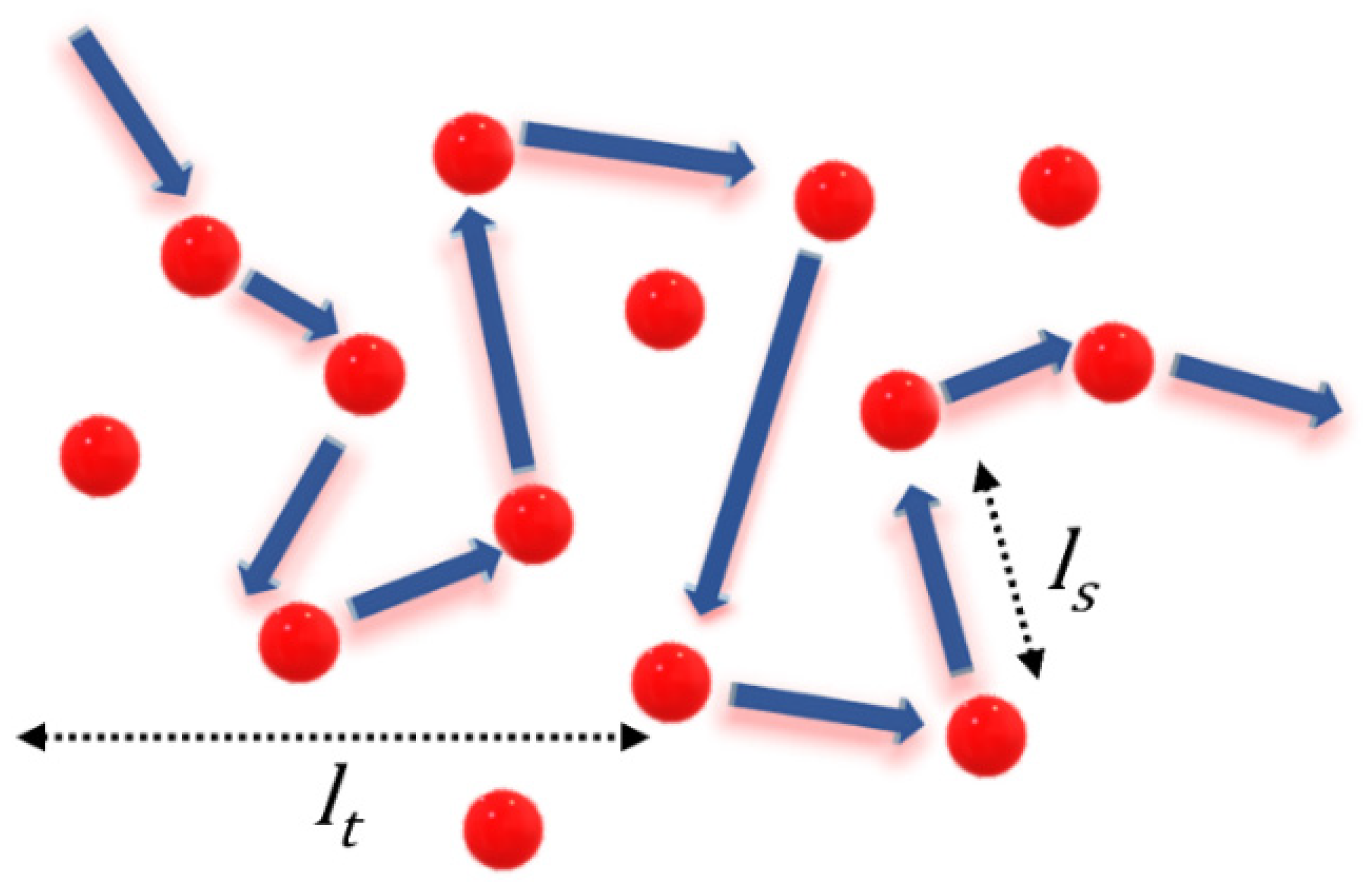

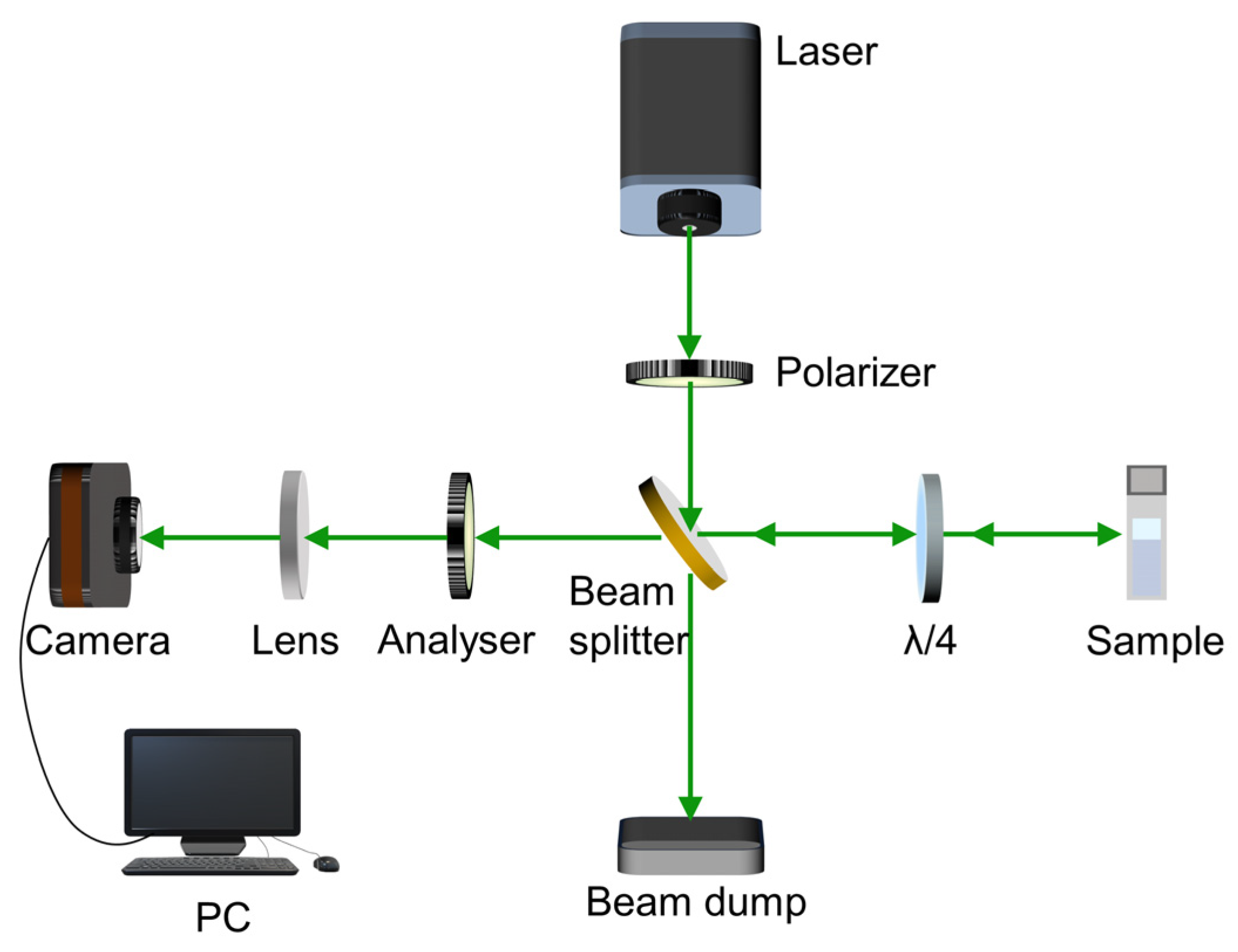

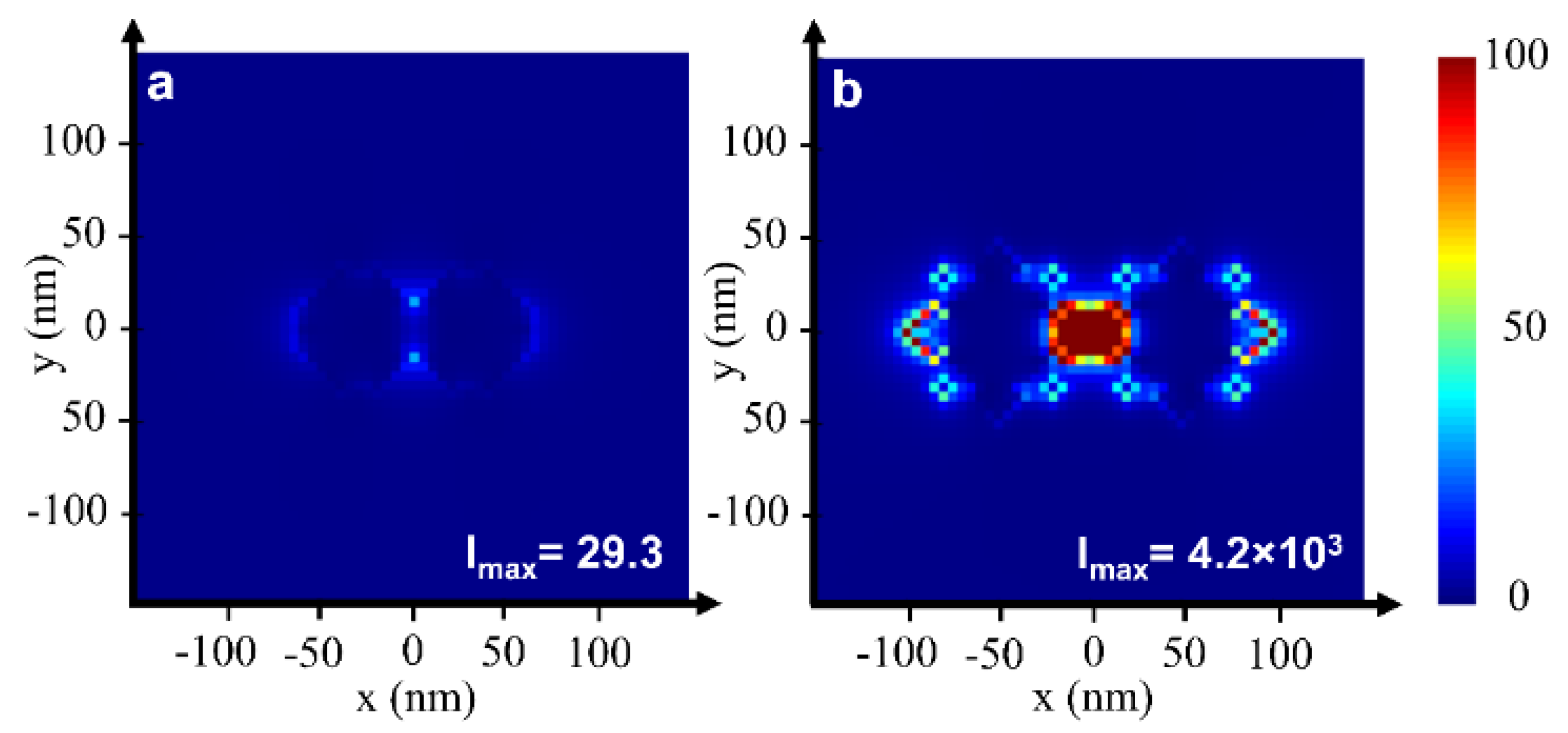
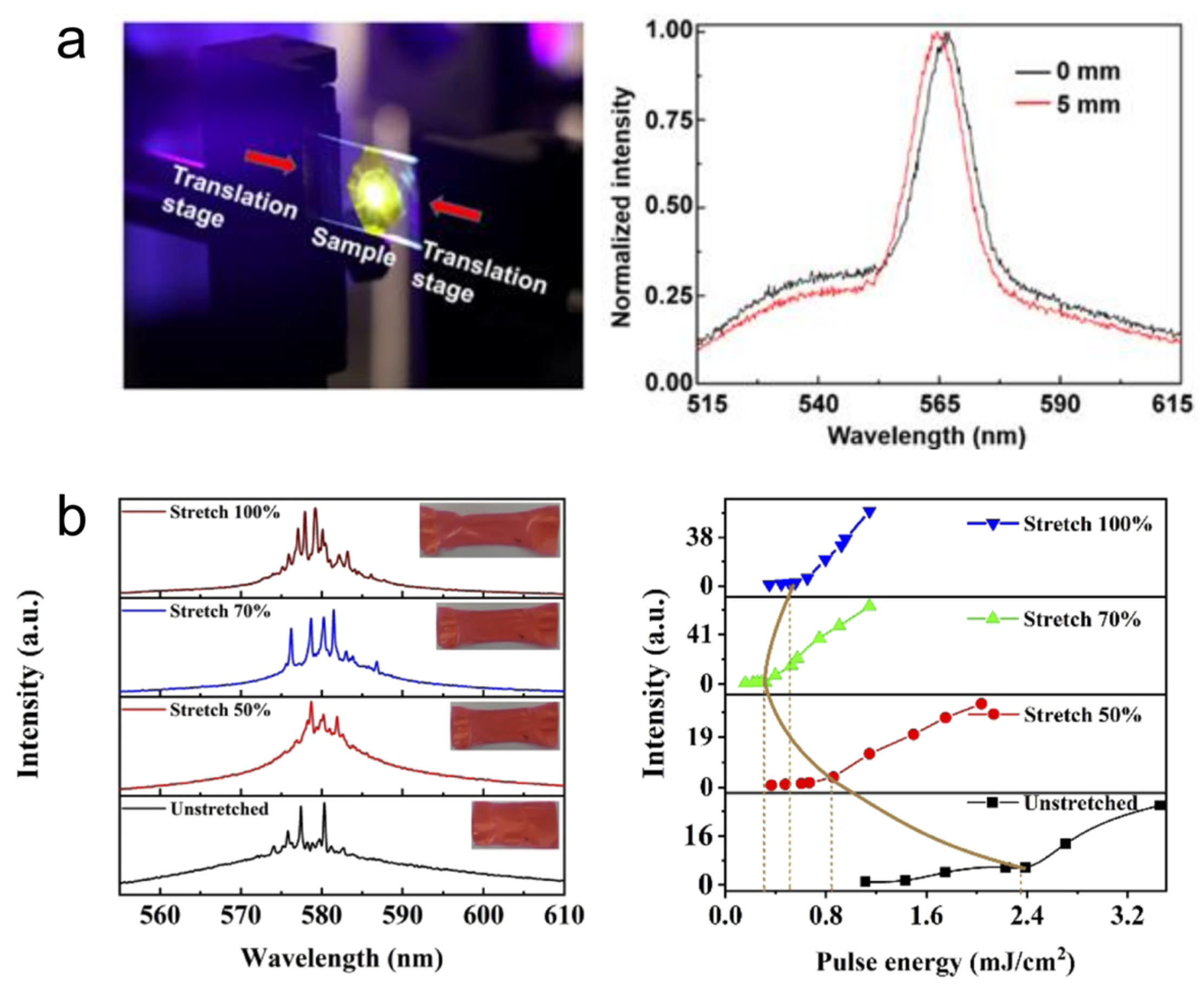

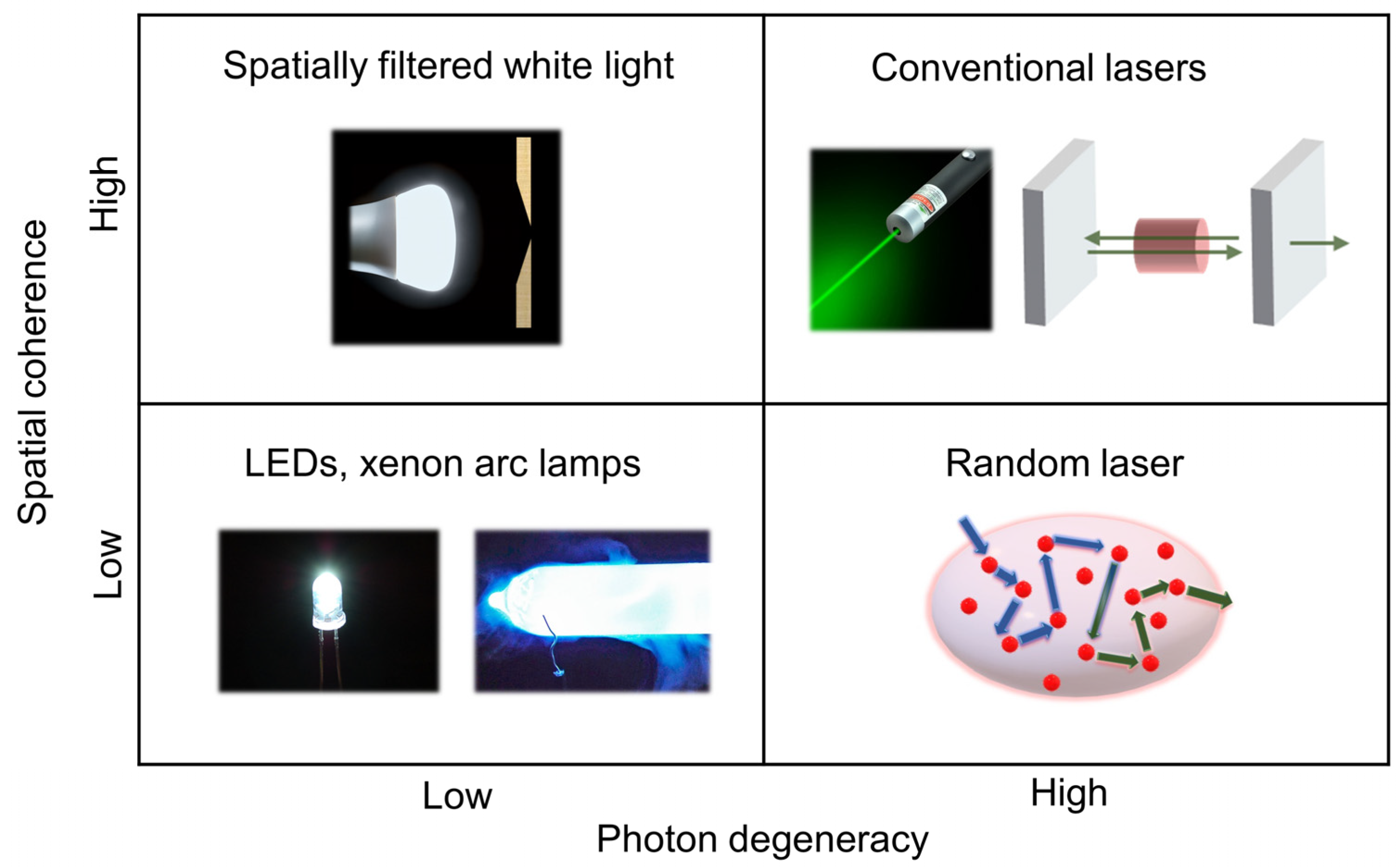
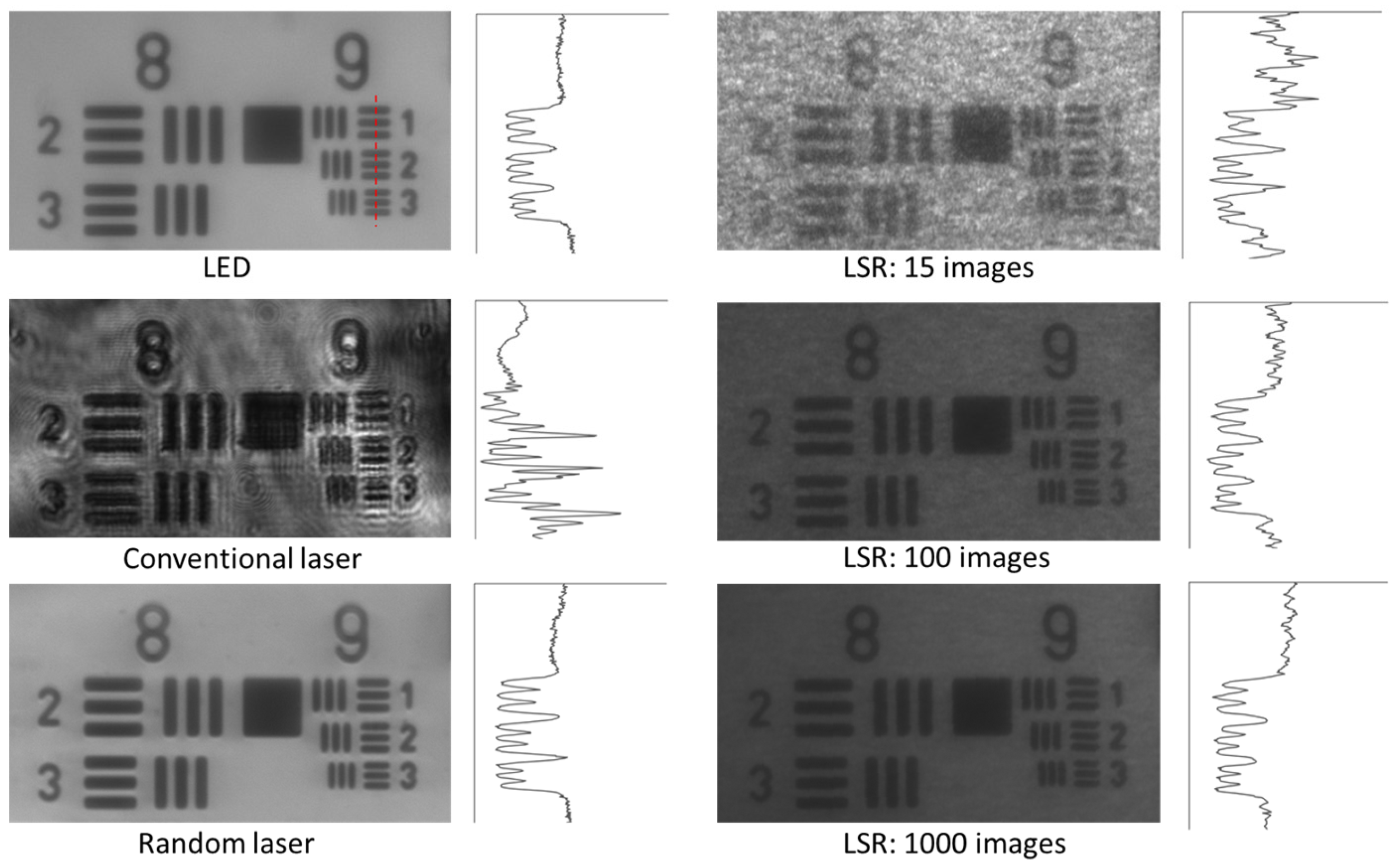
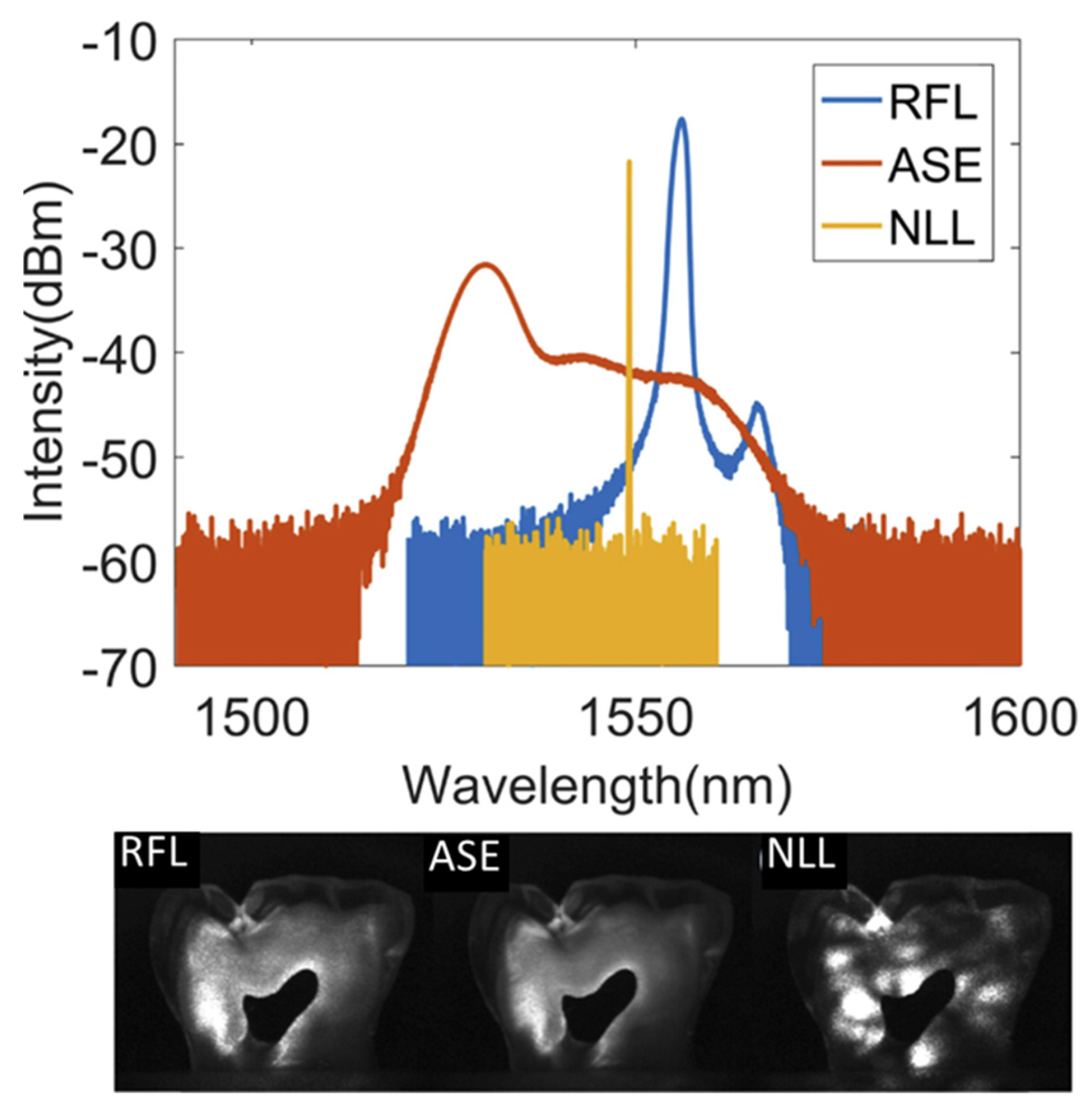

Disclaimer/Publisher’s Note: The statements, opinions and data contained in all publications are solely those of the individual author(s) and contributor(s) and not of MDPI and/or the editor(s). MDPI and/or the editor(s) disclaim responsibility for any injury to people or property resulting from any ideas, methods, instructions or products referred to in the content. |
© 2023 by the authors. Licensee MDPI, Basel, Switzerland. This article is an open access article distributed under the terms and conditions of the Creative Commons Attribution (CC BY) license (https://creativecommons.org/licenses/by/4.0/).
Share and Cite
Gayathri, R.; Suchand Sandeep, C.S.; Vijayan, C.; Murukeshan, V.M. Lasing from Micro- and Nano-Scale Photonic Disordered Structures for Biomedical Applications. Nanomaterials 2023, 13, 2466. https://doi.org/10.3390/nano13172466
Gayathri R, Suchand Sandeep CS, Vijayan C, Murukeshan VM. Lasing from Micro- and Nano-Scale Photonic Disordered Structures for Biomedical Applications. Nanomaterials. 2023; 13(17):2466. https://doi.org/10.3390/nano13172466
Chicago/Turabian StyleGayathri, R., C. S. Suchand Sandeep, C. Vijayan, and V. M. Murukeshan. 2023. "Lasing from Micro- and Nano-Scale Photonic Disordered Structures for Biomedical Applications" Nanomaterials 13, no. 17: 2466. https://doi.org/10.3390/nano13172466
APA StyleGayathri, R., Suchand Sandeep, C. S., Vijayan, C., & Murukeshan, V. M. (2023). Lasing from Micro- and Nano-Scale Photonic Disordered Structures for Biomedical Applications. Nanomaterials, 13(17), 2466. https://doi.org/10.3390/nano13172466





